
 |
Philatelic History of Wilmington, North CarolinaRevised 11/26/2023 |
| (> 1859) Page 1 | (1860-1897) Page 2 | (1898-1916) Page 3 | (1917-1941) Page 4 | (1942-1971) Page 5 | (1972 >) Page 6 |
Philatelic Item |
It is our hope that this web-page will serve to stimulate an interest in the collecting, conservation and documentation of postal history covers of Wilmington.
Wilmington Philatelic Society |
|||
|---|---|---|---|---|
| Year | Pix | Cat # | Description | By |
| On November 10, 1898 Wilmington was the location of what became known as the "Wilmington Riot." Blacks rebelled objecting to laws that provided that all male citizens could vote if they could read and write or if their grandfather voted. This denied most Blacks from the right to vote. There was an entire change in the city government that ushered in the continued prosperity of Wilmington. | ||||
| circa 1900 |
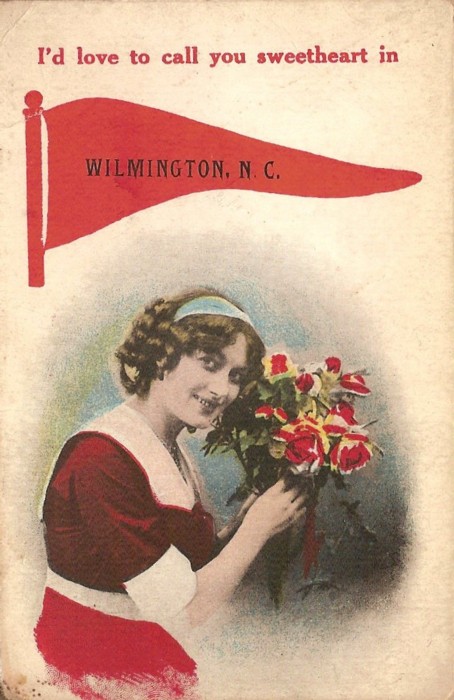
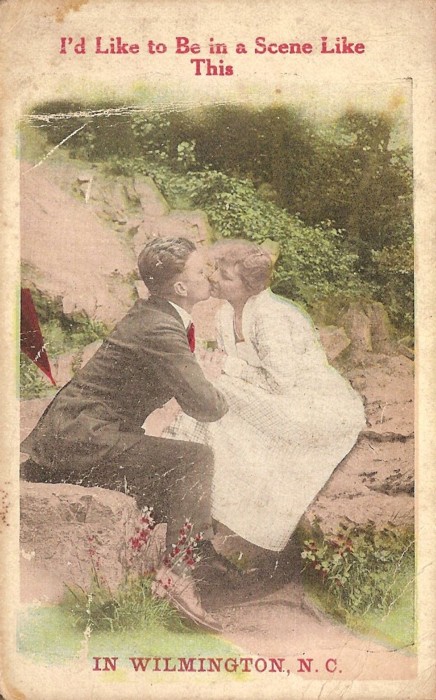
|
--- | Valentine postcards posted from Wilmington NC (circa 1900). History: Saint Valentine's Day is a holiday celebrated on February 14th. It is the traditional day on which lovers express their love for each other often by sending Valentine's cards. Valentine Day is most closely associated with the mutual exchange of love notes in the form of "valentines." Valentine symbols include the heart-shaped outline, doves, flowers and the figure of the winged Cupid. |
JJ |
| 1902 |
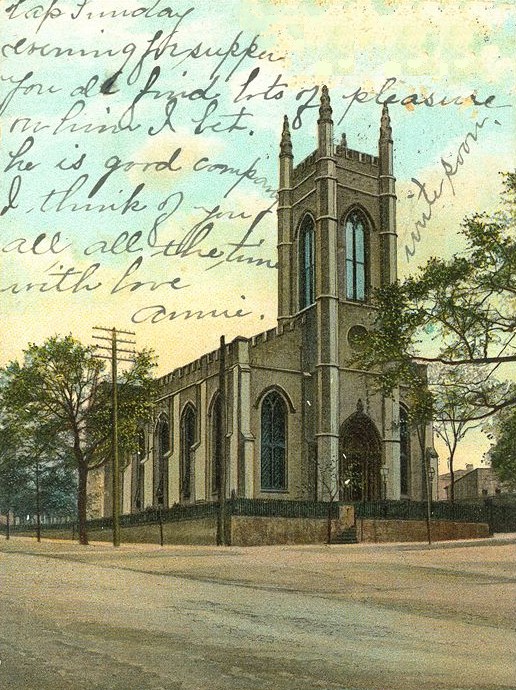
|
--- | A post card (circa 1902) of Saint James Episcopal
Church in Wilmington. History: The Saint James Parish (Wilmington) and its sister church, Saint Philips Parish (Brunswick Town) were established in 1729. The original Saint James Church was completed in 1770. During the American Revolution (1775-1776) Saint James Church was used as a hospital and later as a riding school for the British army. In 1839 the original colonial church was torn down and TU Walter (architect of the Washington Capitol dome) designed the new church in gothic design. Fort Fisher fell on January 15, 1865, followed by the surrender of Wilmington on February 22, 1865. After the Civil War, Wilmington was occupied by Union Troops and Saint James was again used as a hospital. Today Saint James is in the heart of downtown Wilmington and has the distinction of being the oldest church in Wilmington. |
OO |
| 1903 |
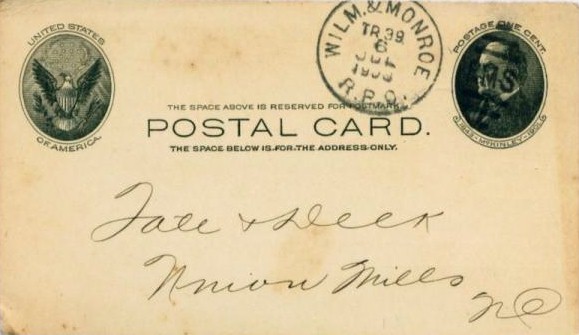 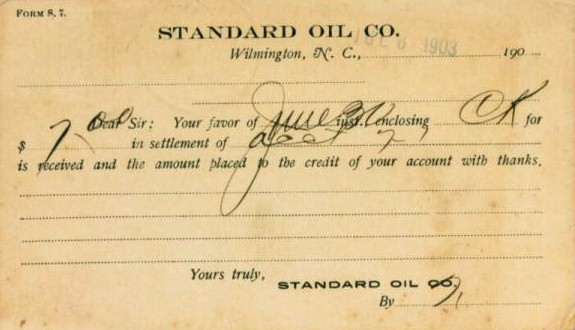
|
UX-18 | A Railway Post Office cover canceled on July 6, 1903 while on the Wilmington-Monroe Railroad and sent to Union Mills NC. History: In 1868 the first Standard Oil Company (Pittsburgh PA) was founded by John D Rockefeller who later would become the richest man of all time. The Standard Oil Company of New Jersey was formed in 1882 to take advantage of New Jersey laws that allowed corporations to own stock in other corporations. By 1892 Jersey Standard became the controlling organization for Standard providing administration coordination to the Standard Oil Trust. The Standard Trust controlled the lion's share of the production, transport, refining and marketing of petroleum products in the United States and many other countries. The emergence of the automobile and its thirst for gasoline brought dizzying wealth to Standard Oil. Rockefeller and his Standard associates developed innovative ways of organizing their oil monopoly. When oil rivals tried to build oil pipelines to overcome Standard's dominance, railroad companies (at Rockefeller's direction) denied permission to run pipelines across railway land forcing competitors to laboriously decant their oil into barrels. Standard Oil developed strong anti-competitive strategies, including a systematic program of purchasing its competitors and artificially lowering oil, kerosene and gasoline prices forcing competitors out of business. In 1904 Standard controlled 91% of petroleum production and 85% of final sales. Most of its output was kerosene of which 55% was exported around the world. The Federal Commissioner of Corporations concluded that Standard's dominant position in the refining industry was due "to unfair practices, to abuse of the control of pipe-lines, to railroad discriminations and to unfair methods of competition. The US Department of Justice sued Standard under federal anti-trust law (Sherman Antitrust Act of 1890) for sustaining a monopoly and restraining interstate commerce. On May 15, 1911 the US Supreme Court upheld the lower court judgment and declared Standard Oil to be an "unreasonable" monopoly under the Sherman Antitrust Act. It ordered Standard to break up into 34 independent companies with different boards of directors. Two of these companies were Jersey Standard (Standard Oil Company of New Jersey) which eventually became Exxon and Socony ("Standard Oil Company of New York") which eventually became Mobil. New Hanover County was served by several railroads including the Seaboard Air Line, the Atlantic Coast Line, and the Wilmington, Brunswick & Southport Railways. Standard Oil petroleum products were transported by rail to the Port of Wilmington for export to foreign markets. The Wilmington-Monroe branch of the Atlantic Coast Line provided passenger/tanker service and also utilized special railroad cars that were staffed by Railway Mail Service postal clerks who would sort mail en route in order to speed mail delivery. The postal mail canceled on these railroad cars received special RPO (Railway Post Office) postmarks. Visit the Wilmington Railroad Museum. |
JJ |
| 1905 |
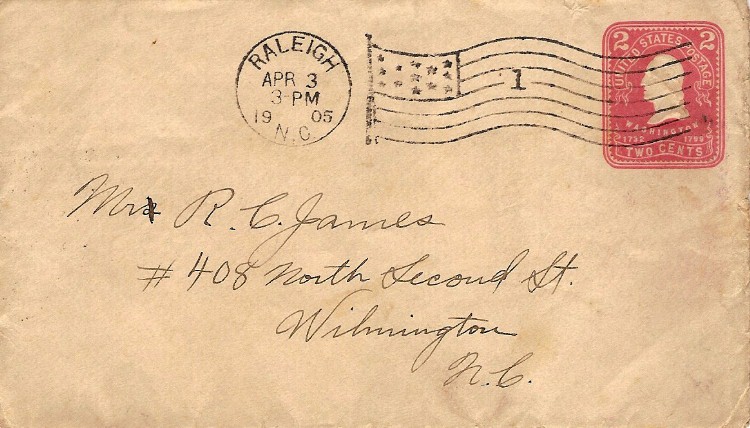
|
U395 | A cover canceled on April 3, 1905 at Raleigh NC and
sent to Wilmington NC. It is canceled with a special "Flag" cancellation. History: The earliest use of a flag cancel was in Boston in 1894. There are thousands of different flag cancels. Flag cancels have been catalogued by Frederick Langford in his "Flag Cancel Encyclopedia. This encyclopedia was compiled in 1965 from original records no longer existing and is illustrated with black & white reproductions of flag cancels. |
LS |
| 1905 |
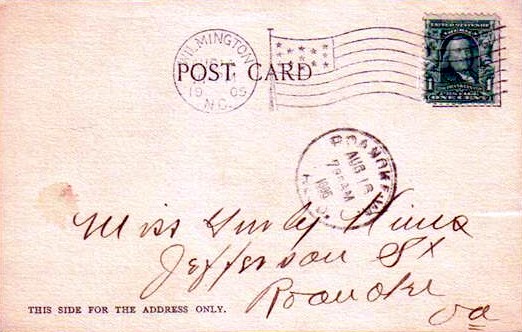
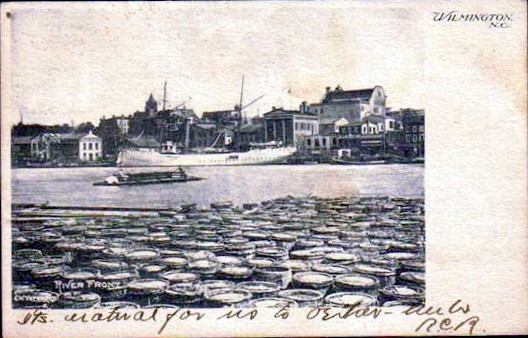
|
300 | A post card canceled on August 14, 1905 at Wilmington
NC and sent to Roanoke VA. It is canceled with a special "Flag" cancellation. The picture on the card shows the
Wilmington waterfront with the US Revenue Cutter Seminole docked near the old Custom's House and the flat ferry
crossing the Cape Fear River. History: The Revenue Cutter Seminole was a 188-foot, 845-ton steamer which was constructed by the Columbian Iron Works in Baltimore MD. She was commissioned in 1900 and saw service through 1934. The Seminole was first based in Boston MA and was transferred to Wilmington NC in late 1904. She patrolled along the southeastern coast cruising from Cape Hatteras NC to Charleston SC and further south to Key West FL. Her duties included derelict destruction, attending local ceremonies, patrolling regattas and rendering maritime assistances. With the outbreak of WW-I she enforced the neutrality laws of the US until the US entered the war. She then served under the US Navy and patrolled off the Carolinas. In 1923 she was detached to Puerto Rico where she served as an independent unit returning to her permanent station of Wilmington later that year. In 1929 the Seminole was transferred to Sault Sainte Marie MI for service on the Great Lakes until her decommissioning in 1934. |
JJ |
| 1905 |
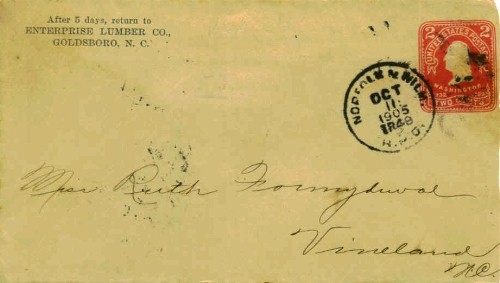
|
U395 | A Railway Post Office cover canceled on October 11, 1905 while on the Norfolk-Wilmington Railroad and sent to Vineland NC. History: New Hanover County was served by several railroads including the Seaboard Air Line, the Atlantic Coast Line, and the Wilmington, Brunswick & Southport Railways. The Atlantic Coast Line moved its headquarters from Wilmington NC to Jacksonville FL in 1961. ACL merged with Seaboard Air Line Railways in 1967 to form the Seaboard Coast Line. The Norfolk-Wilmington branch of the Atlantic Coast Line connected with the main railroad line at Rocky Mount NC (Washington DC to Tampa FL). The Norfolk-Wilmington provided passenger service and also utilized special railroad cars that were staffed by Railway Mail Service postal clerks who would sort mail en route in order to speed mail delivery. The postal mail canceled on these railroad cars received special RPO (Railway Post Office) postmarks. Visit the Wilmington Railroad Museum. |
TB |
| 1906 |
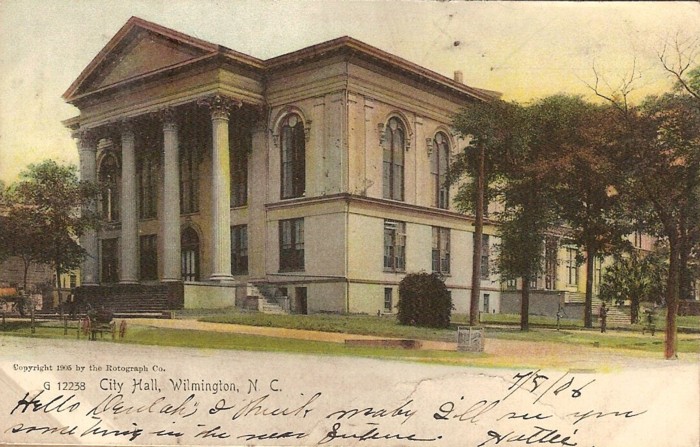
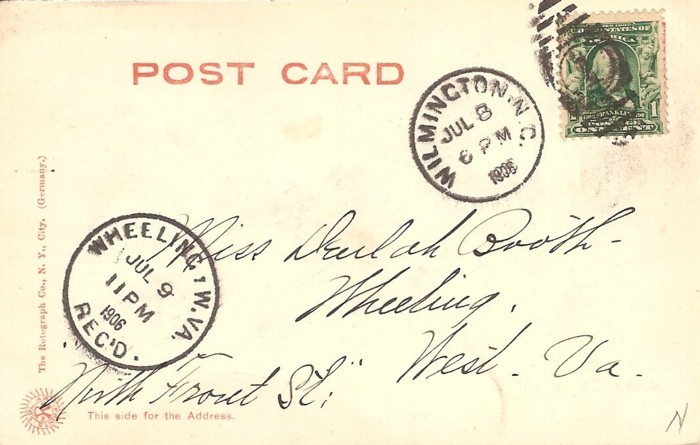
|
300 | A post card cancelled on July 8, 1906 in Wilmington NC
with a picture of City Hall (1st home of the Library) in Wilmington. History: The construction of City Hall/Thalian Hall was completed in 1858 when Wilmington was the largest city in the state of NC. In March 1901 the North Carolina Sorosis (Federated Women’s Club - Margaret Littlejohn Kingsbury) led the community in obtaining Wilmington's first free public library. Later on December 1, 1906 Wilmington's Public Library opened its doors on the second floor of City Hall. For a short period between January 16, 1939 and December 1940, the library was closed while the north wall of City Hall was repaired from a structural collapse. It remained at City Hall until 1956 when it was moved to the Armory Building. On July 16, 1956 it was dedicated as the Wilmington Light Infantry Memorial Library remaining there until 1981. In 1981 the New Hanover Country Public Library moved into the Belk-Berry building at 201 Chestnut Street where the Main Library remains today. Branch library locations have since been opened in Myrtle Grove, Military Cutoff, Carolina Beach and the Law Library in the Court House. Visit the New Hanover County Public Library. |
JJ |
| 1906 |
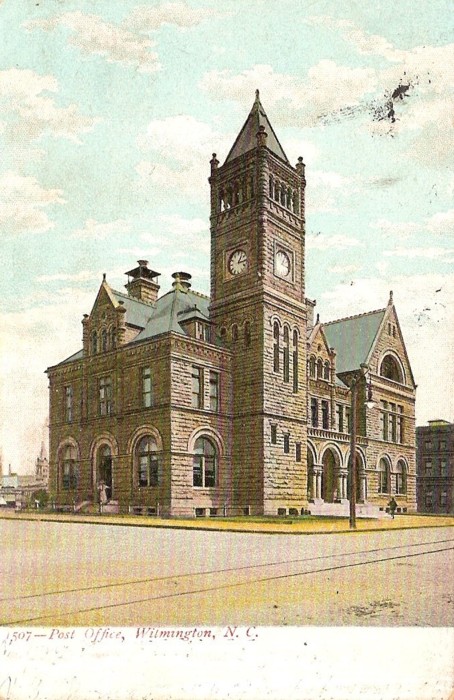
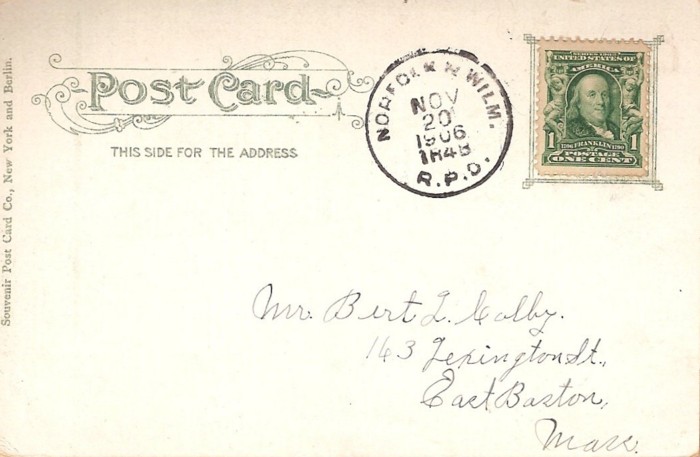
|
300 | A post card cancelled on the Norfolk & Wilmington
Railroad on November 20, 1906 sent to East Boston MA. History: On July 26, 1775 the Second Continental Congress meeting in Philadelphia established an American Post Office with Ben Franklin as Postmaster General. It provided a line of posts from Falmouth in New England to Savannah, Georgia. Several years later on October 5, 1789 the first postmaster, John Bradley was assigned to Wilmington to operate the post office as a colonial office. Early Wilmington post offices were located in stores and hotels and the Postmasters were paid by a percentage of the mail they processed. The first post office in Wilmington was located in the old Custom House which was completed in 1846. It remained in that Federal Building until 1874 when a two-story brick building was erected on the southwest corner of Second and Chestnut Streets. In 1888 the construction of a main post office began on the site of the former home of RR Bridges at the corner of Front and Chestnut Streets. It was completed in 1891 and was made of brown granite from Wadesboro NC. It had two faces carved over the entrance, one happy and the other, dejected. Patrons rumored that one face had received a letter and the other received none. It was locally called the, "Brownstone Post Office." |
JJ |
| 1907 |
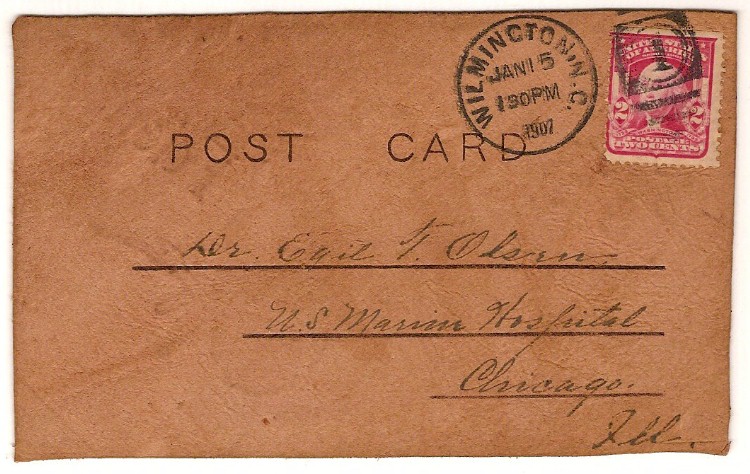
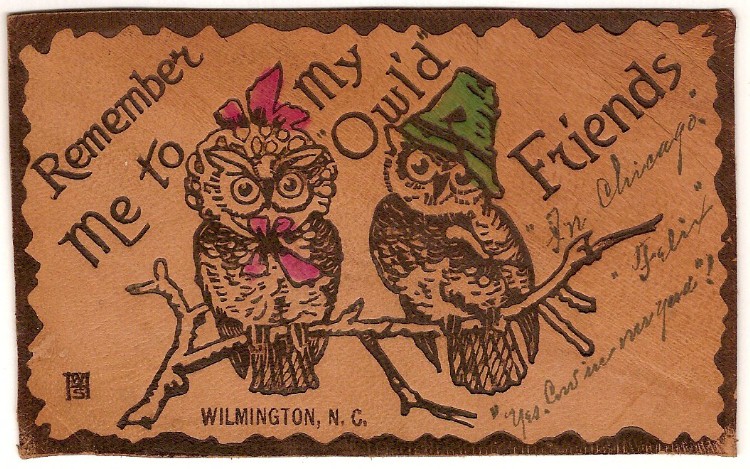
|
319 | A leather post card canceled on January 15, 1907 in Wilmington NC sent to Chicago IL. History: In 1905 there were over fifty ale-houses, taverns and saloons in downtown Wilmington. Wilmington was a seaport in every way. Ships flying the flags of every nation jammed the Wilmington harbor to load tar, pitch and turpentine. Sailors and seamen were a thirsty, colorful, brawling and noisy bunch of patrons that contributed to the local economy. Brave local residents and tourists mingled with the maritime crowd at these downtown seaport establishments. In 1907 Wilmington was attracting tourists with its sun and fun atmosphere. For years and years temperance, prohibition and indulgence policies oscillated in America as well as North Carolina. When the clock in the Courthouse tower at 3rd and Princess Streets struck midnight on December 31, 1908, Wilmington when dry and over sixty saloons closed their doors. Bootleggers began a flourishing business and roadhouses increased where illegal corn whiskey, "white lightning" and "stump hole" could be purchased. America when dry on January 16, 1920 after the enactment of the 18th Amendment. It was repealed in 1933. Alcoholic Beverage Control (ABC) stores under the management of the State opened in Wilmington in 1935. |
JJ |
| 1907 |
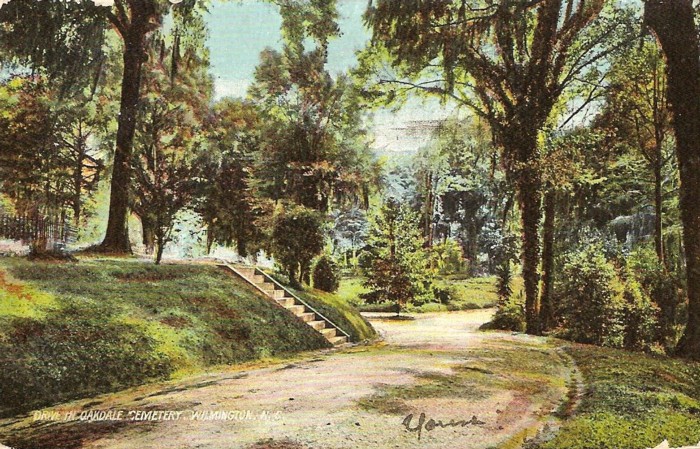
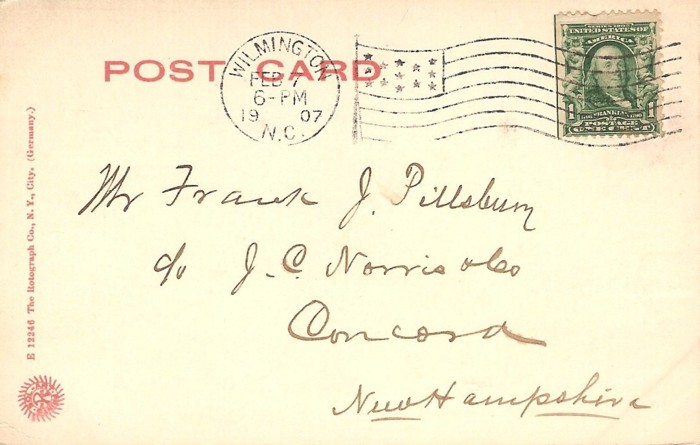
|
300 | A post card cancelled on February 7, 1907 and sent to Concord NH. It shows a road in Oakdale Cemetery. History: The Oakdale Cemetery is a sprawling historic graveyard on North 15th Street. It holds several sites with important Civil War connections. A monument, inscribed "To the Confederate Dead" was erected in 1870 atop the mass grave where the Confederate casualties from Fort Fisher were re-buried in 1866. The Confederate national flag, the "Stars and Bars" flies from a flagpole behind the monument. Elsewhere in Oakdale, a large expanse of untended ground amid the orderly rows of tombs is the site of mass burials of yellow fever victims during an 1862 epidemic. Not far away from Oakdale is the Wilmington National Cemetery located on Market Street at 21st Street. This cemetery was established in 1867 for the graves of the Union dead from the battles of Fort Fisher and Forks Road. Its stones list hundreds of identified casualties, identifying them by their home states or as "US Army Regulars" or as "US Colored Troops." Many others mark the final resting place of "US Unknown Soldiers." |
JJ |
| 1907 |
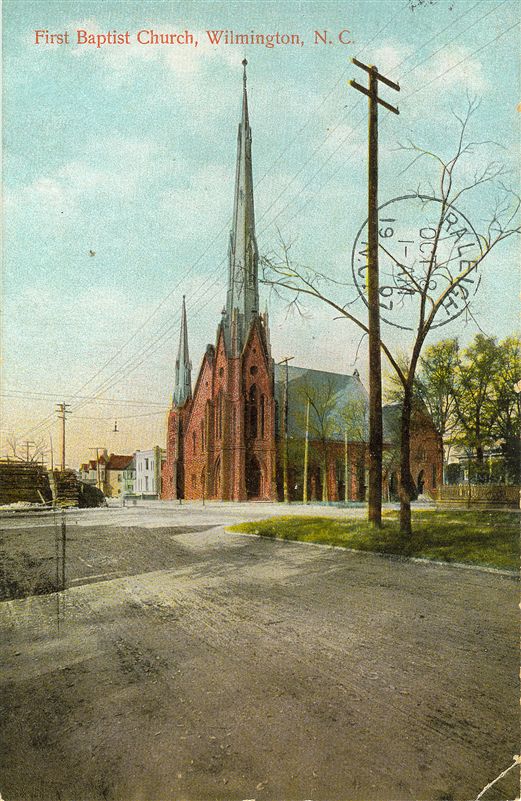
|
--- | A post card (circa 1907) of the
First Baptist Church in Wilmington. History: The First Baptist Church of Wilmington was founded in 1808 as the Front Street Baptist Church located at Front and Ann Streets (Baptist Hill) in Wilmington North Carolina. Construction on the present church on Market Street began in 1860. It was designed by architect, Samuel Sloan of Philadelphia in early English Gothic style. Fort Fisher fell on January 15, 1865, followed by the surrender of Wilmington on February 22, 1865. After the Civil War, Wilmington was occupied by Union Troops and construction of the Baptist Church was delayed due to the lack of needed materials. The foundation of the church was constructed with the stone ballast from ships coming into the Port City. Popular church folklore says that some of that ballast rock came from the pirate Blackbeard’s ship when he heaved a load of ballast into the Cape Fear River to gain speed and escape from his pursuers. The Church was completed in 1870. In 1996 Hurricane Fran’s toppled the First Baptist Church’s 197-foot-tall steeple which was then rebuilt in 1998. |
OO |
| 1907 |
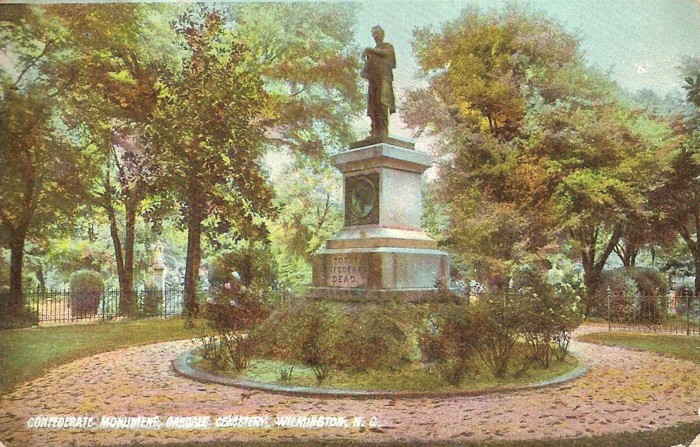
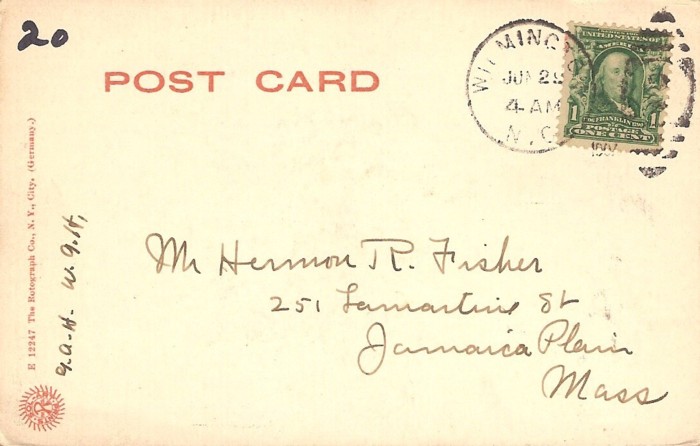
|
300 | A post card cancelled on June 29, 1907 and sent to Jamaica Plain MA. It shows the Oakdale Cemetery monument, inscribed "To the Confederate Dead" which was erected in 1870 atop the mass grave where the Confederate casualties from Fort Fisher were re-buried in 1866. |
JJ |
| 1907 |
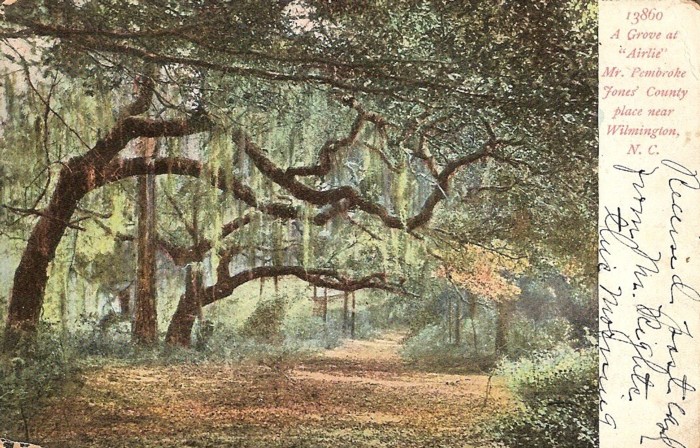
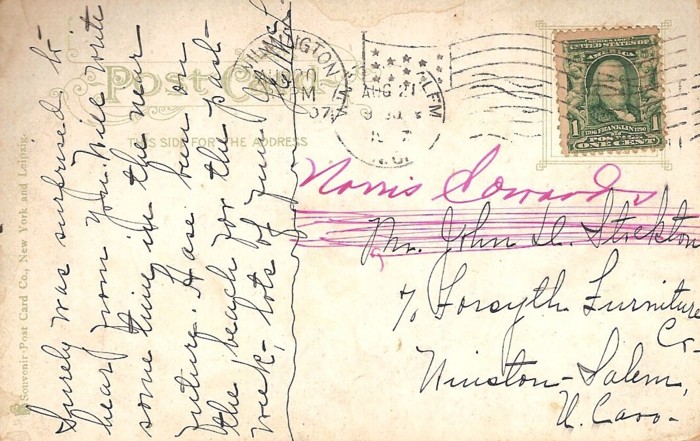
|
300 | A post card cancelled on August 20, 1907 and sent to
Winston-Salem NC. It shows a grove in what is now called "Airlie Gardens." History: The "Airlie" property was part of a 640-acre 1735 land grant from King George II to the Ogden brothers. By the 1800s much of this acreage along Bradley Creek had been transferred to Joshua Grainger Wright and later to Pembroke Jones. Jones’s wife, Sarah manicured the rustic greenery into formal gardens where wealthy industrialists gathered for lavish entertaining and parties. The name "Airlie" had been derived from the Airlie Oak found on the property. Sarah Jones began planting on the property in 1901 and later in 1906 commissioned German landscape architect, Rudolf Topel to transform Airlie into a picturesque garden. Later in the 1920s Airlie had over a half million azaleas and 5,000 camellias. Portions of the original track were sold to residential development leaving today’s "Airlie" at 67-acres. The Corbett Family purchased the "Airlie" property from the Jones’ in 1948 using the gardens as their primary residence. From time to time, the Corbetts’ opened their garden to the public to enjoy its blooming azaleas, camellias etc. In 1999 the property was sold to New Hanover County where the "Airlie Gardens" are preserved for public use and enjoyment. |
JJ |
| 1908 |
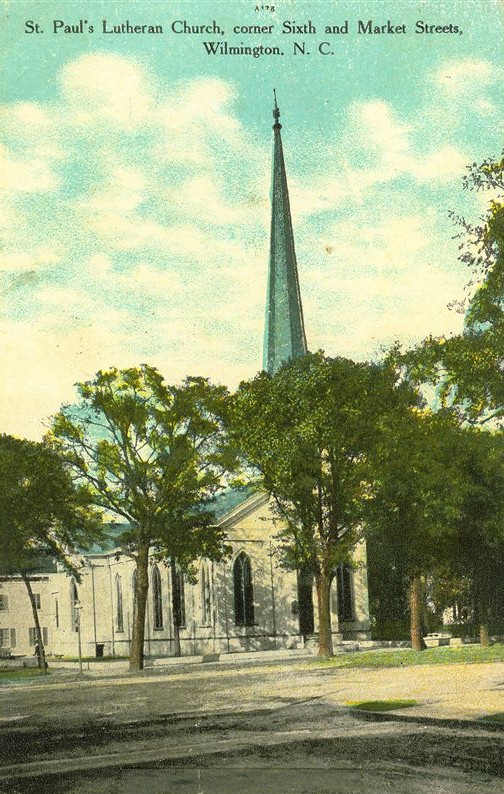
|
--- | A post card (circa 1908) of
Saint Pauls Lutheran Church in Wilmington. History: The cornerstone of Sant Pauls Lutheran Church was laid on September 6, 1859 and the congregation began worship services and a Sunday School program in the vestry room in 1861. Fort Fisher fell on January 15, 1865, followed by the surrender of Wilmington on February 22, 1865. After the Civil War, Wilmington was occupied by Union Troops and the unfinished Saint Pauls Church was used as a horse stable for the Union headquarters setup in the nearby Bellamy Mansion. The Saint Pauls Church building was finally completed and dedicated on August 22, 1869. A parochial school was begun in 1876 drawing pupils not only from church membership, but from the community at large. In 1907/08 Saint Pauls added an annex and the church was changed from a simple building to a basilica. The present church was redecorated in 1937 and again in 1946. |
OO |
| 1908 |
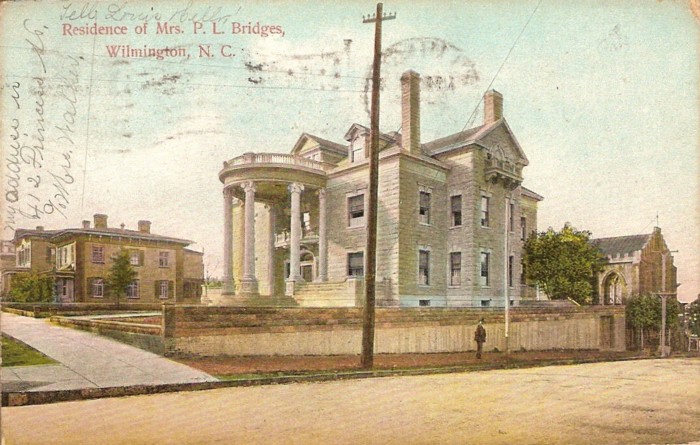
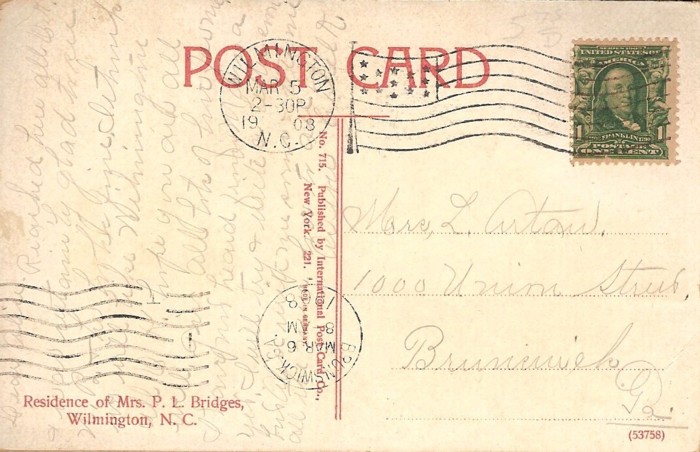
|
300 | A post card cancelled on March 5, 1908 and sent to Brunswick GA. It shows the Bridges' residence." |
JJ |
| 1908 |
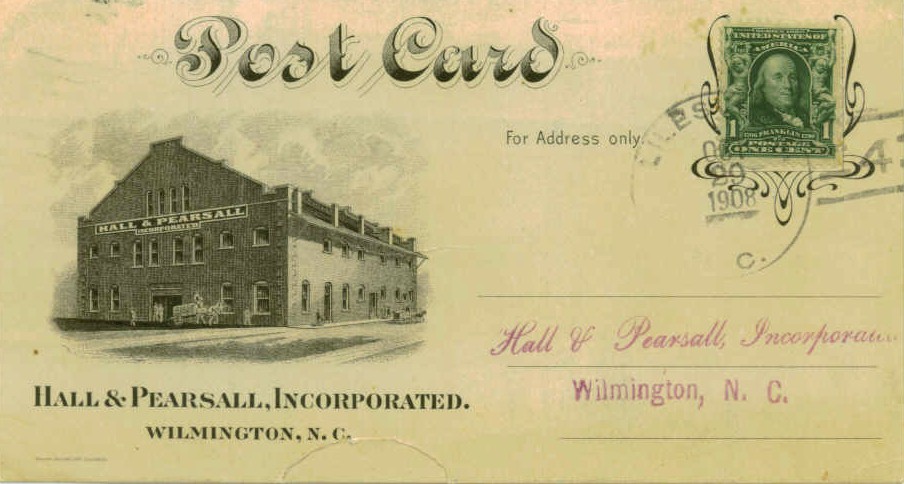
|
300 | A post card sent on October 29, 1908 from SF Usher in Lilesville NC to Hall & Pearsall (Wholesale Grocer & Commission Merchant), Wilmington NC. History: After Jacob J Edwards died in 1876, the commission merchant business "Edwards & Hall" was dissolved and a new co-partnership "Hall and Pearsall" was formed between Benjamin Franklin Hall and Oscar Pearsall with his brother, Philander. The "Hall and Pearsall" wholesale grocer and commission merchant warehouse was located at 713-719 Nutt Street in downtown Wilmington. Oscar Pearsall achieved some notoriety in 1894 when he barged his Carolina Beach cottage to Wrightsville Beach where it was rebuilt. Later in 1903 he moved one of AJ DeRosset houses from the northeast corner of Third & Market Streets and built the Colonial Inn on that site. The Colonial burned down in 1962. In 1913 Oscar built the Presbyterian Church on Market Street which bears his name. Hall & Pearsall owned the schooner, "Katie Edwards" that was used for coastal trading from Wilmington up and down the coast carrying produce, turpentine and other goods. |
FO |
| 1909 |
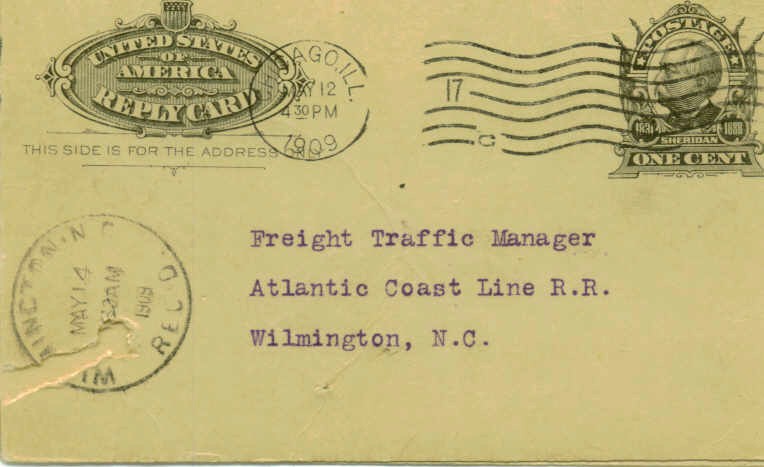
|
UY-4 | A postal card sent on May 12, 1909 from Chicago IL to Freight Traffic Manager, Atlantic Coast Line Railroad in Wilmington NC. History: The Atlantic Coast Line Railroad (ACL) was the product of numerous mergers of dozens of smaller rail lines in the last three decades of the 19th century. It began as the Wilmington & Raleigh Railroad (later renamed Wilmington & Weldon Railroad) constructed between 1834 & 1840 in northeastern North Carolina. After the Civil War, the railroad's owners acquired the Wilmington & Manchester Railroad which was quickly reorganized as the Wilmington, Columbia & Augusta Railroad. In 1871 they began using the name Atlantic Coast Line as a market name for the two lines. Other rail lines in the Carolinas and Virginia were acquired over the next quarter century and various joint ownership and partnership agreements were established. A permanent connection to Augusta GA became a problem. It was not until 1897 when the stock of the Charleston & Western Carolina Railway was purchased, that Augusta came securely into the fold. In 1897-98 the various South Carolina lines were consolidated into a new company, the Atlantic Coast Line Railroad Company of South Carolina. On August 8, 1899 it acquired from the Central of Georgia Railroad as half-interest in the lease of the Georgia Railroad. This gave ACL rail connections to Atlanta and Macon GA. Meanwhile, consolidation of ACL component railroad companies continued in North Carolina and Virginia. Although the owners had decided to bring all of their railroads into a single company, it was determined that a state-by-state approach to consolidation was necessary given the varying regulations of each state. The Atlantic Coast Line Railroad Company of Virginia was established in early 1898 and the Atlantic Coast Line Railroad Company of North Carolina was given approval by the NC legislature the following year. The most favorable regulatory climate was in Virginia and the ACL's owners chose that state as the base for the combined company. The consolidation was accomplished in early 1900 when the ACL of Virginia absorbed the other companies and dropped the Virginia part of its name to become the Atlantic Coast Line Railroad Company. The Seaboard Air Line Railway was created in the 1880s by the consolidation of the Seaboard and Roanoke Railroad. Eventually, over 100 railroad lines would be incorporated into the Seaboard Air Line Railway. On July 1, 1900 the entire system was consolidated and became reorganized as the Seaboard Air Line Railway, a 2600-mile network stretching from Virginia to Florida. The Seaboard Air Line name had been used as a marketing name rather than the name of the company. The Atlantic Coast Line Railroad headquarters moved from Wilmington NC to Jacksonville FL in 1961. ACL merged with Seaboard Air Line Railways in 1967 to form the Seaboard Coast Line. Visit the Wilmington Railroad Museum. |
RP |
| 1909 |
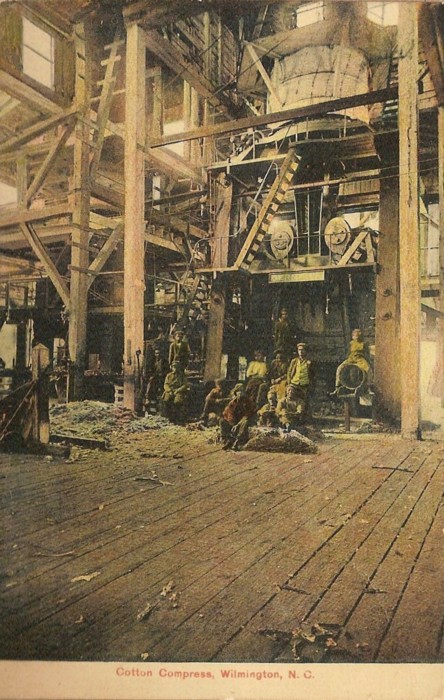
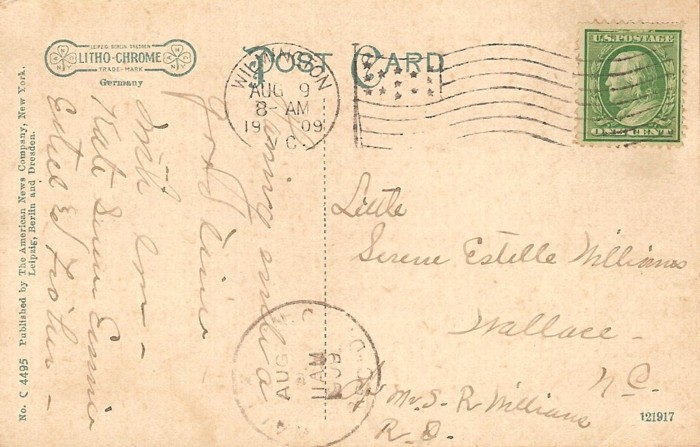
|
331 | A post card cancelled on August 9, 1909 and sent to Wallace NC. It shows a cotton compress in Wilmington NC. |
JJ |
| 1909 |
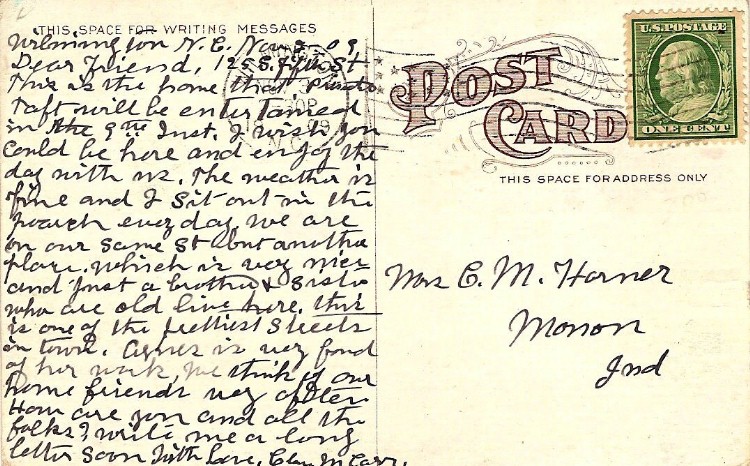
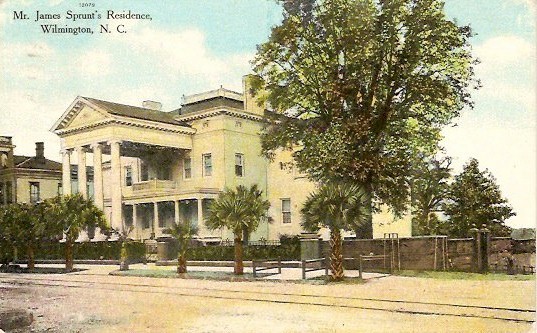
|
3403 | A post card of the James Sprunt residence canceled on November 3, 1909 at Wilmington NC. This post card was sent six days prior to President Taft's visit to Wilmington and shows the Sprunt residence where Taft stayed while in Wilmington. History: William Howard Taft was the 27th President of the US, the tenth Chief Justice of the Supreme Court, a leader of the progressive conservative wing of the Republican Party in the early 20th century, a pioneer in international arbitration and a staunch advocate of world peace. He became President in January 1909 and brought the "motor age" into his presidency. He was the first president to own a car at the White House having converted the White House stables into a 4-car garage. On a southern motor tour, Taft visited Wilmington NC ("Land of the Long Leaf Pine") on November 9, 1909 staying at the James Sprunt residence. While in Wilmington he had a full day of banquets and speeches. During his administration, the US parcel post system began and Congress approved the 16th Amendment providing for the levying of an income tax. Taft was the only former President to serve on the Supreme Court. He was 72 when he died on March 8, 1930 in Washington DC and was the first President to be buried in the National Cemetery in Arlington VA. |
JJ |
| 1910 |
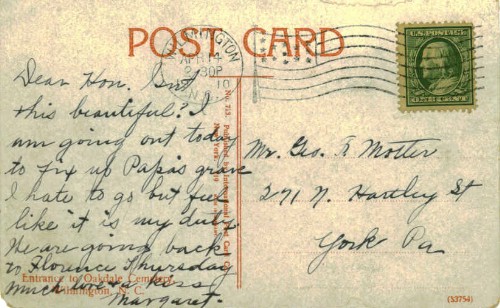
|
374 | A postal card sent by Margaret on April 14, 1910 from Wilmington to her brother, George Motter in York PA. The reverse side of this post card shows the entrance to Oakdale Cemetery. History: Wilmington is honored to have its Oakdale Cemetery. This sprawling historic graveyard on North 15th Street holds several sites with important Civil War connections. A monument, inscribed "To the Confederate Dead" was erected in 1870 atop the mass grave where the Confederate casualties from Fort Fisher were re-buried in 1866. The Confederate national flag, the "Stars and Bars" flies from a flagpole behind the monument. Elsewhere in Oakdale, a large expanse of untended ground amid the orderly rows of tombs is the site of mass burials of yellow fever victims during an 1862 epidemic. Not far away from Oakdale is the Wilmington National Cemetery located on Market Street at 21st Street. This cemetery was established in 1867 for the graves of the Union dead from the battles of Fort Fisher and Forks Road. Its stones list hundreds of identified casualties, identifying them by their home states or as "US Army Regulars" or as "US Colored Troops." Many others mark the final resting place of "US Unknown Soldiers." |
WT |
| 1910 |
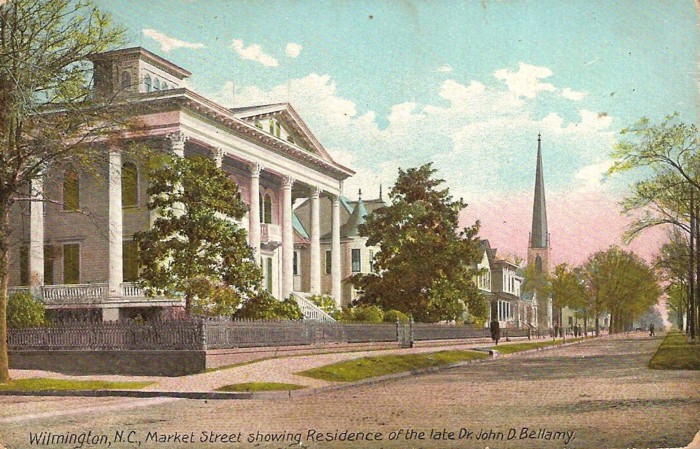
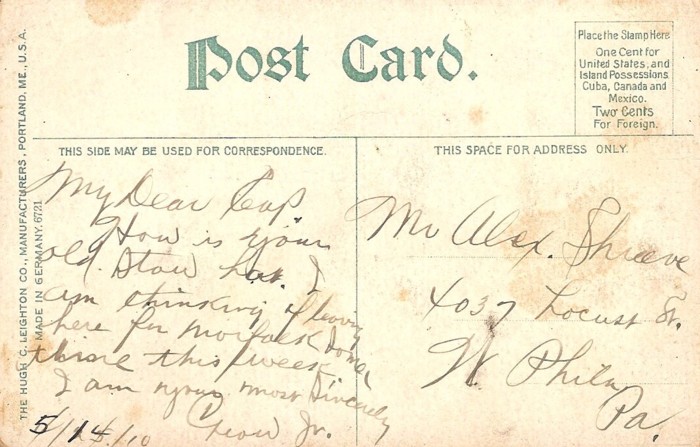
|
--- | A post card cancelled on May 14, 1910 and sent to West Philadelphia PA. It shows the Bellamy Mansion residence in Wilmington NC. |
JJ |
| 1910 |
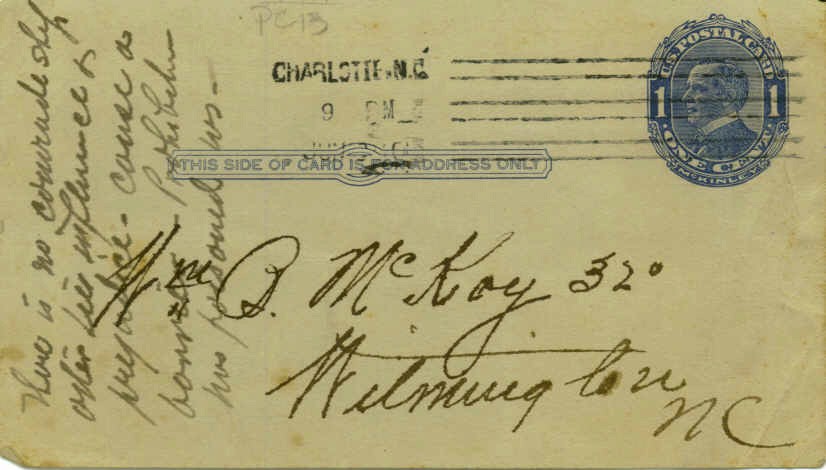
|
UX-21 | A postal card sent on June 12, 1910 from Charlotte NC to William Berry McKoy in Wilmington NC. History: McKoy was a prominent attorney in Wilmington. He was a well-known figure in the State Democrat Party and in the Masonic Order. See post card dated 1879 above for more details. |
FO |
| 1911 |
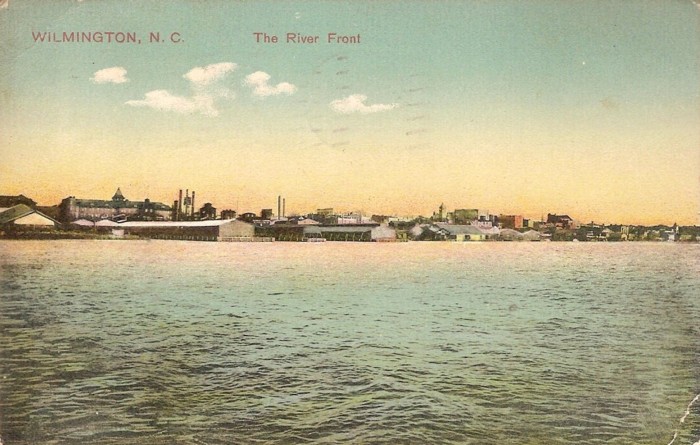
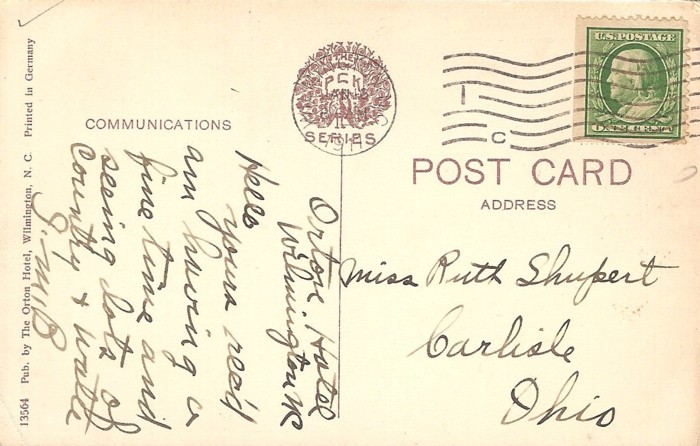
|
331 | A post card cancelled on January 16, 1911 and sent to Carlisle OH. It shows the Wilmington NC riverfront. |
JJ |
| 1912 |
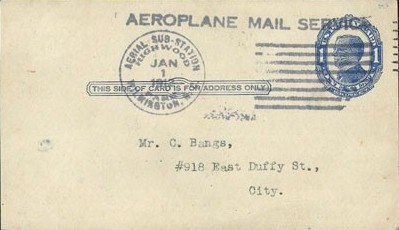
|
UX-22 | A postal card carried on January 2, 1912 from Highwood Park Aerial Sub-Station (Highwood Park) in Wilmington and sent to C Bangs in Wilmington NC. History: Bad weather on January 1st prevented the flight from taking place. The next day the weather cleared and pilot, Walter Brookins flew his Wright-Breguet aeroplane carrying a mailbag with approximately 1,600 pieces of mail (canceled on Januaury 1, 1912) over a distance of three miles. The mailbag was dropped by Brookins over Winter Park and was then retrieved by a postal clerk transporting it the post office by automobile for further dispatch in the postal system. Wilmington Postmaster, Thomas E Wallace authorized the establishment of a postal sub-station at Highwood Park and this aerial transport of mail. |
OO |
| In 1912 Wilmington had 30,000 residents living in the midst of unrivaled prosperity. With it's deep-water port and the South's finest cotton compresses, it was North Carolina's largest banking resource. | ||||
| 1914 |
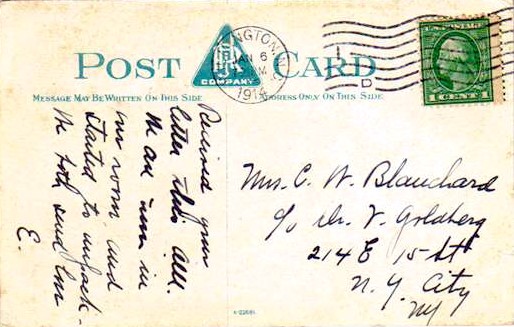
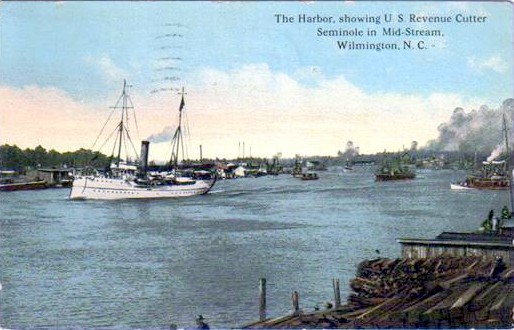
|
405 | A post card canceled on January 6, 1914 at Wilmington NC and sent to New York City NY. The picture on the card shows the Wilmington Harbor on the Cape Fear River with the US Revenue Cutter Seminole in mid-stream. History: See Description in 1905 above. Additionally, in the next year, 1915 the US Coast Guard would be formed from the merger of the Revenue Service with the Lifesaving Service. |
JJ |
| 1914 |
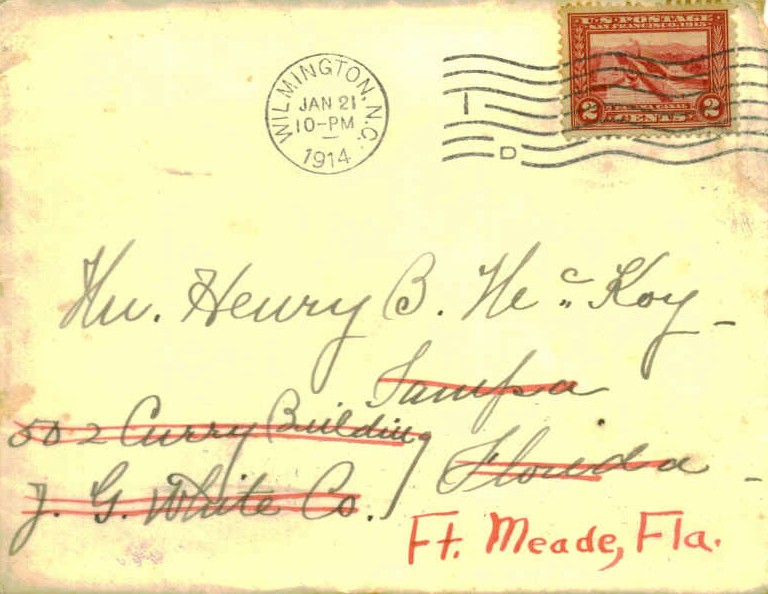
|
398 | A cover sent on January 21, 1914 from Wilmington NC to Henry Bacon McKoy in Fort Meade Florida. History: William Berry McKoy (see 1879 & 1910 above) had two sons, James Hasell McKoy (see 1938 below) and Henry Bacon McKoy. Amongst several books that Henry authored was the "McKoy Family of North Carolina" and "Do You Remember When." In his 'Remember When' book McKoy states that in Wilmington, "We went Coonering each year after the festivities of the Christmas Day had gone by. The boys of my neighborhood around the turn of the century engaged in ‘Coonering' no other time except between Christmas Day and the New Year. A group of five to ten boys would don whatever costume or garment he was able to get. There were sashes and shawls, overcoats and long pants. There were red bandannas, shirts and dresses. Everything had to be old and ill fitting. And then there was always the mask or 'Cooner' face." |
RP |
| 1914 |
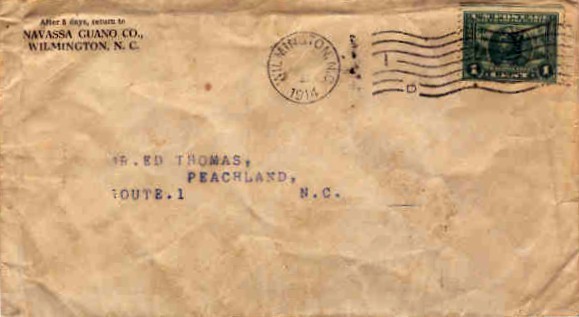
|
397 | A cover sent in 1914 from the Navassa Guano Company, Wilmington NC to Ed Thomas in Peachland NC.(see 1890 above) History: Navassa Island which was located off the west coast of Haiti in the Caribbean Sea was owned by the Navassa Guano Company, Wilmington NC. The Spanish-American War of 1898 had forced the guano operations of Navassa to evacuate and subsequently file for bankruptcy. Navassa Island was abandoned in 1901 and went into private ownership. It became significant again with the opening of the Panama Canal in 1914. Shipping between the American eastern seaboard and the newly opened Panama Canal had to pass between Cuba and Haiti. Navassa Island had always been a hazard to navigation and needed a lighthouse. The US Lighthouse Service built a 162 foot tower on the island in 1917, 395 feet above sea level. A keeper and two assistants were assigned to live there until the US Lighthouse Service installed an automatic beacon in 1929. After absorbing the Lighthouse Service in 1939, the US Coast Guard serviced the light twice each year. The US Navy set up an observation post for the duration of WW-II. The island has not been inhabited since then. The Panama Canal had been constructed in two stages. The first stage (1881 to 1888) was carried out by a French group of companies headed by de Lessop. The second stage was done by the US who completed the canal. The Panama Canal opened for ship traffic on August 15, 1914 eleven days after war was declared between Germany and Great Britain. The US entered WW-I on April 6, 1917. |
OO |
| 1915 |
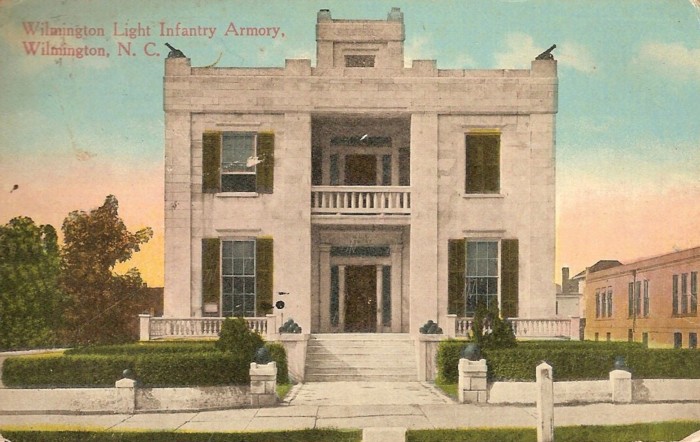
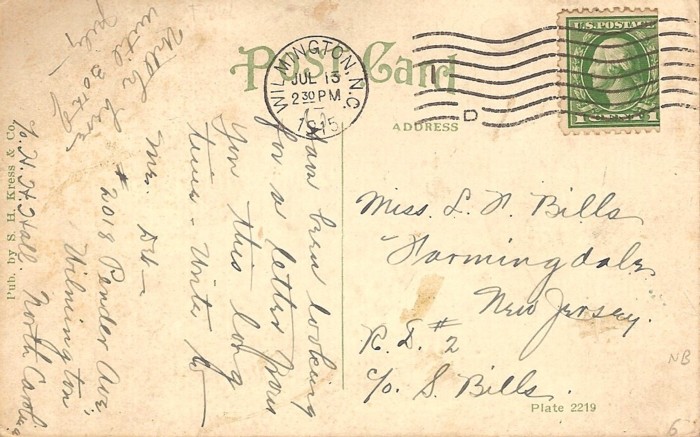
|
424 | A post card cancelled on July 13, 1915 and sent to Farmingdale NJ. It shows the Light Infantry Armory in Wilmington NC. |
JJ |
| 1916 |
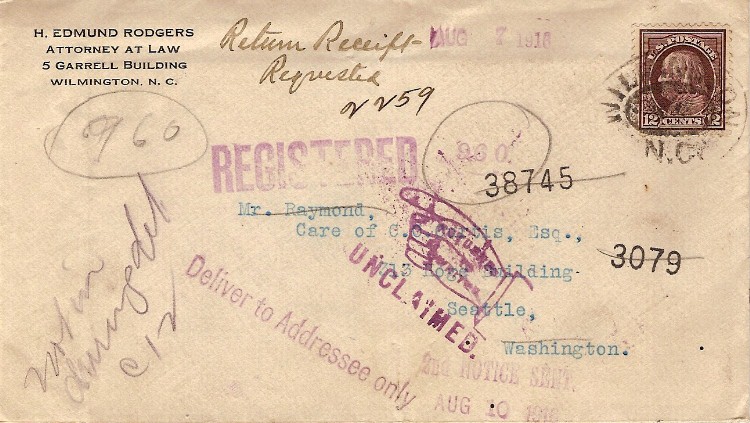
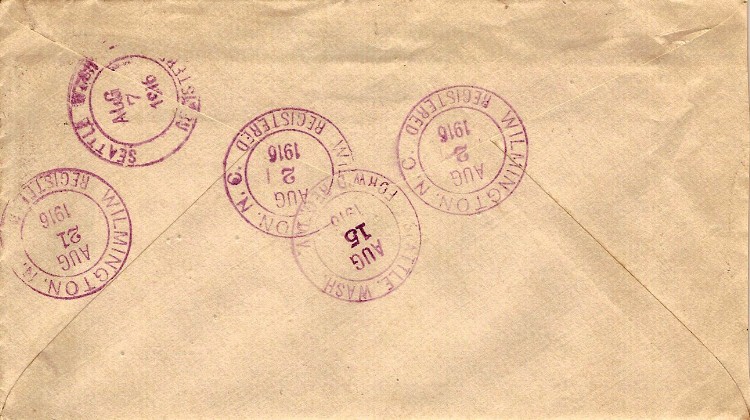
|
417 | A cover canceled on August 2, 1916 at Wilmington NC
and sent to Seatle WA. It was sent via registered mail by H Edmund Rodgers, Attorney at Law in Wilmington. History: Harry Edmund Rodgers (1885-1969), a native of Dayton OH was an attorney and dean of the Wilmington Law School in Wilmington NC. His office/law school was in the Garrell Building located on the southwest corner of north Second Street between Market and Princess Streets. His wife, Lillian was also an attorney and professor at the Law School which operated in Wilmington from 1913 to 1941. The Rodgers lived at 220 south Second Street. H Edmund Rodgers was a Republican candidate for US Representative from North Carolina in the 7th District in 1946. He was defeated by J Bayard. The law firm of "Rogers and Rodgers" was active into the early 1960s. |
LS |
| 1916 |
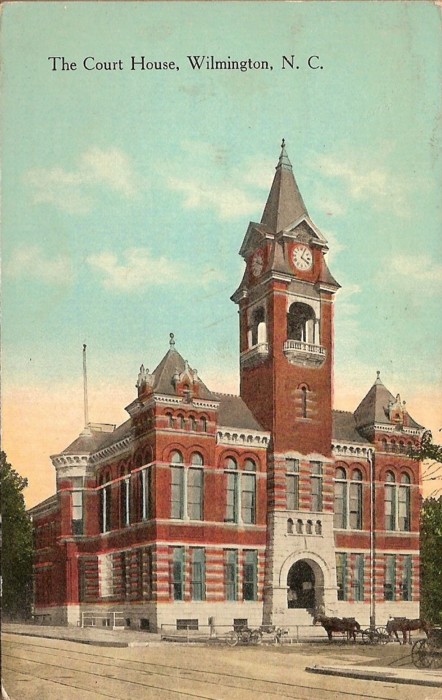
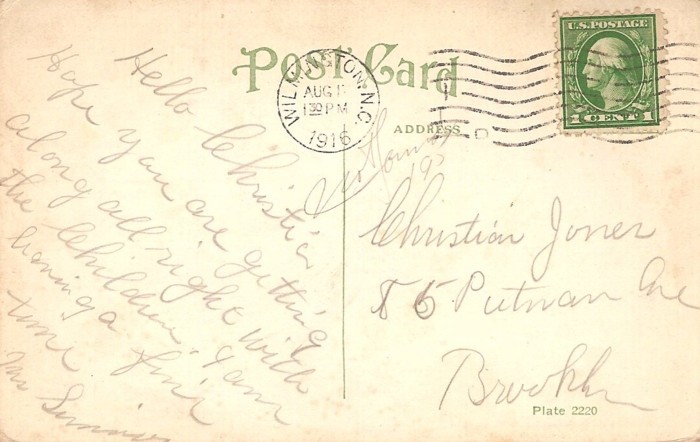
|
424 | A post card cancelled on August 12, 1916 and sent to Brooklyn NY. It shows the Court House in Wilmington NC. |
JJ |
| (> 1859) Page 1 | (1860-1897) Page 2 | (1898-1916) Page 3 | (1917-1941) Page 4 | (1942-1971) Page 5 | (1972 >) Page 6 |